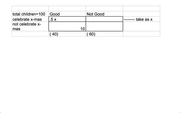rjain84 wrote:In 1997, N people graduated from college. If 1/3 of them received a degree in the applied sciences, and, of those, 1/4 graduated from a school in one of six northeastern states, which of the following expressions represents the number of people who graduated from college in 1997 who did not both receive a degree in the applied sciences and graduate from a school in one of six northeastern states?
(A) 11N/12
(B) 7N/12
(C) 5N/12
(D) 6N/7
(E) N/7
Here's the Double Matrix method step-by-step:
Note: This technique can be used for most questions featuring a population in which each member has two criteria associated with it.
Here, the criteria are:
- degree(applied sciences or not)
- school location(north eastern state or not)
In 1997, N people graduated from college.
 1/3 of them received a degree in the applied sciences
1/3 of them received a degree in the applied sciences
 Of those (1/3)N students, 1/4 graduated from a school in one of six northeastern states.
Of those (1/3)N students, 1/4 graduated from a school in one of six northeastern states.

In other words, (1/12)N students have a degree in applied sciences
and graduated from a northeastern school.
Which of the following expressions represents the number of people who graduated from college in 1997 who did not both receive a degree in the applied sciences and graduate from a school in one of six northeastern states?
If the box that has (1/12)N students in it represents the students with a degree in applied sciences
and graduated from a northeastern school, then the remaining boxes (shaded in blue) must represent the students who did not both receive a degree in the applied sciences and graduate from a school in one of six northeastern states.

Since all 4 boxes must add to N (the total number of students), the 3 shaded boxes must add to [spoiler](11/12)N[/spoiler].
Answer =
A
Cheers,
Brent
Aside: For more information about the Double Matrix method and some additional practice questions, check out these 3 BTG articles:
-
https://www.beatthegmat.com/mba/2011/05/ ... question-1
-
https://www.beatthegmat.com/mba/2011/05/ ... question-2
-
https://www.beatthegmat.com/mba/2011/05/ ... question-3


























